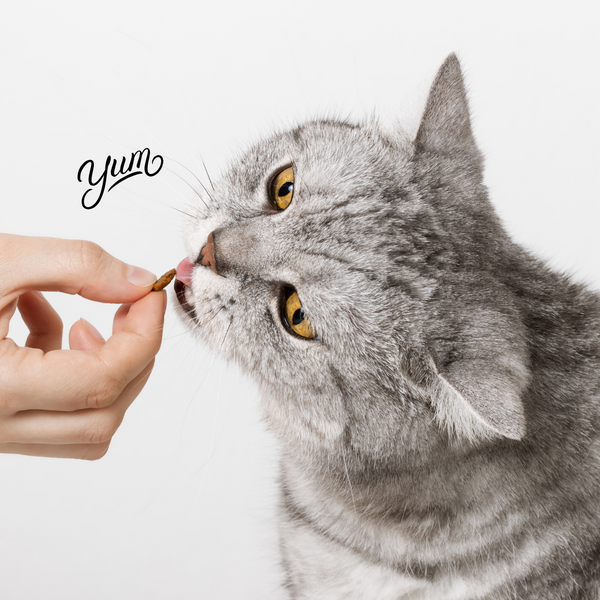
Quality Pet Treats - What to Look For and What to Avoid
(Dr. Iulia Mihai, DVM) You've probably noticed how your pet instantly lights up when they see you with a delicious treat in your hand, right? Well, treats are a joy for any dog or cat at any time. They are not just treats for our furry friends, they are real tools that help us communicate with them, show them our affection, and motivate them.
However, too many treats can lead to obesity or unwanted behaviors. In addition, it's also important to keep in mind that the kind of treat you give your pet matters. With thousands of treats available today, choosing the right one is not easy at all. It is up to you to filter, research, and find out what is best to avoid.
Why Treat Quality Matters
In addition to motivating your dog or cat, treats also play a role in their overall health and well-being. A high-quality treat can provide additional nutrients in addition to their daily diet, support oral health, and strengthen the bond between you and your pet.
Lower-quality treats are filled with artificial additives and excess sugar and salt, which can lead to health problems like weight gain, allergies, digestive upset, and even long-term health issues.
The ingredients and nutritional value of your treats should matter just as much as your dog or cat’s regular diet. If you choose carefully, your pet will enjoy something tasty and healthy which will help them live a longer and happier life.
Understanding the Role of Treats in Your Pet’s Diet
Treats serve many purposes. They can be a snack, an effective training tool, a good way to clean your pet’s teeth and promote oral health, or a support for joints or digestion. However, it should be noted that treats only complement a balanced diet - they do not replace it. Overfeeding treats can lead to health problems and nutritional imbalances. Understanding the role of treats in your pet’s diet will help you make careful choices that are tailored to your dog's or cat’s needs without compromising their health. In addition, moderation and quality are essential to keeping your pet happy and healthy.
What to Consider When Choosing Treats for Your Pet?
1. Ingredients
One of the most important factors to consider when buying treats (and pet food) is the ingredient list. As mentioned earlier, treats can have a significant impact on your pet’s diet. Choose treats that are as natural as possible and contain few ingredients. Avoid those that contain additional or unnecessary fillers. Some treats even contain toxic chemicals that can be harmful to your pet’s health. Even though symptoms may not be immediately noticeable, they can lead to chronic health problems. You should avoid treats that contain any of the following ingredients:
-
Preservatives
-
Chemical humectants – can lead to digestive problems.
-
Artificial colors – some may be harmful.
-
Synthetic sweetener (e.g., xylitol) – it is added to improve taste, but specifically xylitol is toxic to pets and can even lead to death.
-
Treats high in sugar, salt, or fat – these can have a negative impact on your pet's health and can lead to obesity, diabetes, dental problems, kidney disease, and heart disease.
You should also avoid treats that contain unsafe ingredients or of questionable origin (such as low-quality meat by-products, unknown fillers, or additives that have not been properly tested for safety). Additionally, avoid treats that do not meet manufacturing standards as they may be contaminated (with toxins, bacteria, or heavy metals). The best for your pet is to always look for treats from reputable brands with transparent sourcing and clear ingredient lists.
2. Calorie and Nutritional Content
Offer your pet treats that fit within your pets' overall dietary needs.
You should be aware that even small amounts can add up to too many of your pet's daily calories and can quickly lead to weight gain. In general, treats should not make up more than 10% of their daily caloric intake.
3. Buy Products Based on Your Pet’s Age and Medical History
Due to their rapid growth rate, puppies and kittens need treats that are relatively higher in calories than those of adult pets. According to studies, older pets cannot digest proteins and fats as well as they could when they were younger. Be sure to visit your veterinarian if your pet has a medical history so that they can advise you on the best diet for them. Just like humans, pets can have dietary restrictions based on their health and may react negatively to certain ingredients.
If your young or adult pet has allergies, intolerances, or food sensitivities, it is best to choose hypoallergenic treats.
4. Treats Size and Texture
The size of the treat should be appropriate for your pet's size (this applies mostly to dogs). Therefore, a very small dog should not have large treats, and vice versa. Small dogs can choke on large treats, and large dogs may eat more treats than needed just because they are small.
The texture of the treat is also important. Treats that are a bit firm and hard will benefit your pet's oral health. This helps prevent the buildup of plaque and tartar. However, if you have an older pet, offer softer treats to ease the strain on their damaged teeth or weak gums.
What Treats to Choose for Your Puppy or Kitten
For puppies and kittens, treats are important for both training and showing appreciation. It’s essential to balance taste with nutritional value. Therefore, choosing healthy treats like chicken, turkey, sweet potatoes, pumpkin, or eggs will be tasty while also providing health benefits. If you decide to make your own, keep in mind that cooking the treats matters, as high temperatures can reduce or destroy nutrients.
When your puppies or kittens are teething, opt for soft, easy-to-chew treats that will soothe their gums and won’t damage sensitive teeth. Avoid hard or sugary treats and those that contain unhealthy ingredients. Natural, wholesome treats are the safest and most beneficial for your pet’s development and comfort.
When to Talk To a Vet
When you're not sure what type of treat is right for your pet, consult your veterinarian. They can give you the best advice based on your dog's or cat's weight, age, and health. In addition, your veterinarian can help you avoid treats that may cause digestive problems, allergies, or weight gain.
Incorporating Treats into Training and Bonding
As mentioned earlier, treats are not only delicious snacks but also a tool that will help you strengthen your relationship with your dog or cat and help with training. Used correctly, treats can motivate your pet to adopt positive behaviors and respond better to commands.
What you need to remember is that treats should be offered immediately after your dog or cat has adopted the desired behavior. For example, if your dog is in training and you tell them to “sit” and they fulfill the command, offer them a treat immediately. This will make your dog understand that immediately after they respond to a command, they will receive something tasty, positively associating the command with the treat.
For frequent training sessions, choose small, low-calorie treats to avoid overeating and weight gain. A variety of healthy treats will keep things interesting and stimulate your pet’s appetite without compromising their daily diet. You can pair treats with verbal praise and petting, which reinforces a sense of security and trust, strengthening your bond.
You can also keep your pet mentally stimulated by integrating treats into interactive activities such as puzzles or hide-and-seek games.
Iuliana graduated from the University of Agronomical Sciences and Veterinary Medicine in 2012, Romania. She has a Master’s degree in Small Animal and Equines Pathology and a strong affinity for Veterinary Parasitology and Laboratory. In 2013 she started her Ph.D. in epithelial cancer in dogs and cats. She volunteered at the faculty’s clinic in her 3rd year of study, and continued her career in small animal pathology and laboratory. She has one cat and eleven rats. Her interests outside of work include traveling, writing, and crafting.

Post a Comment!